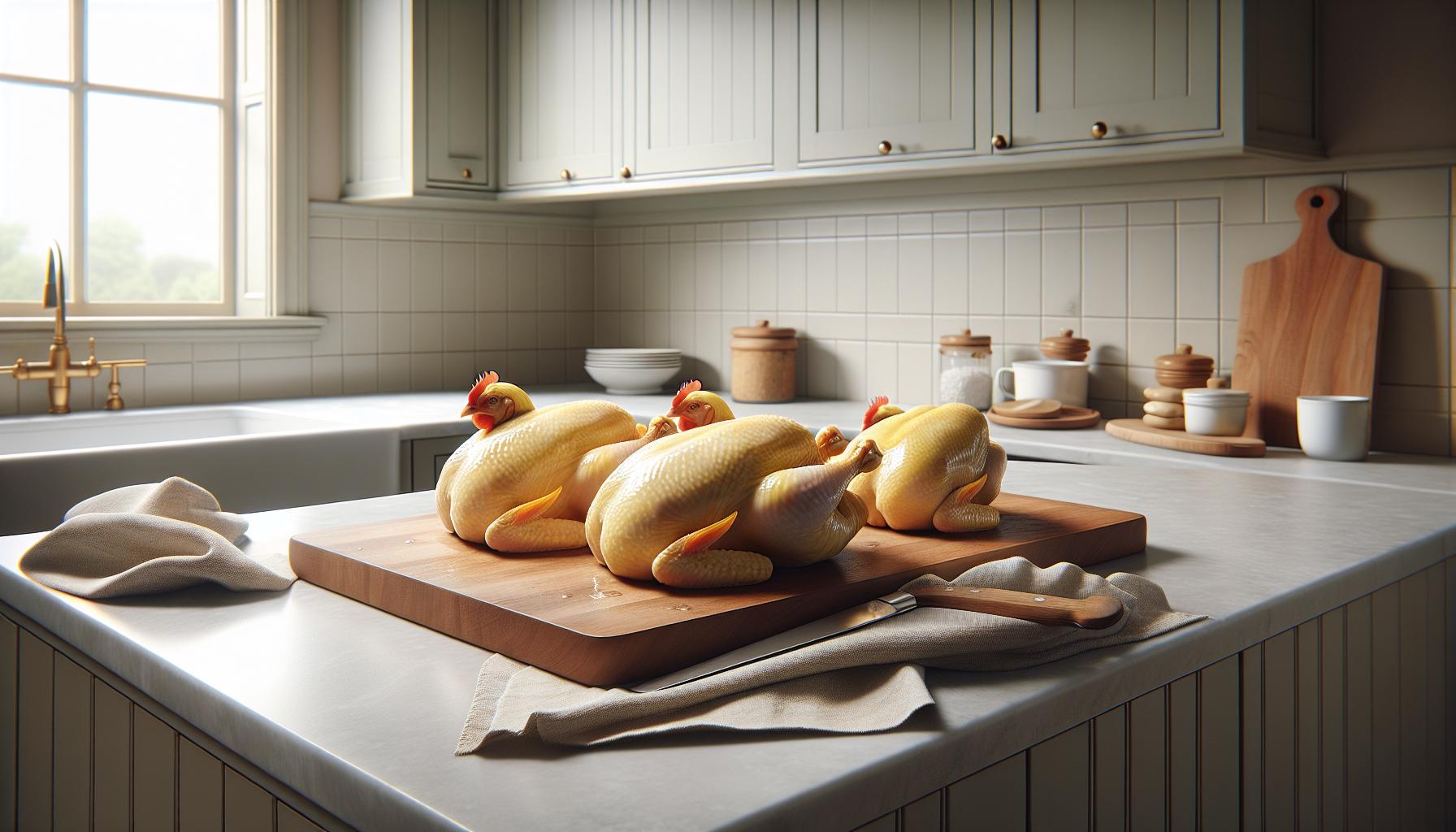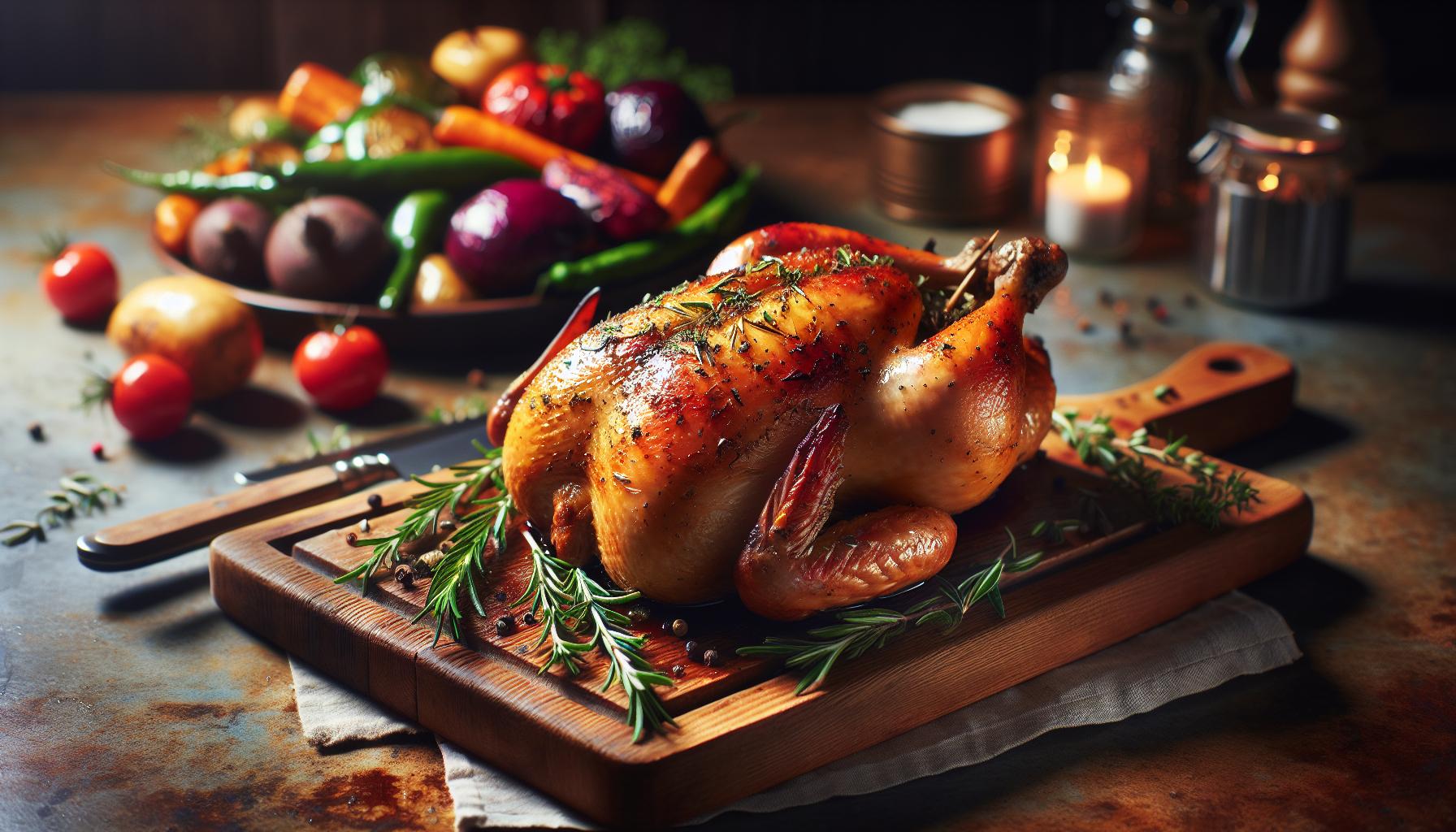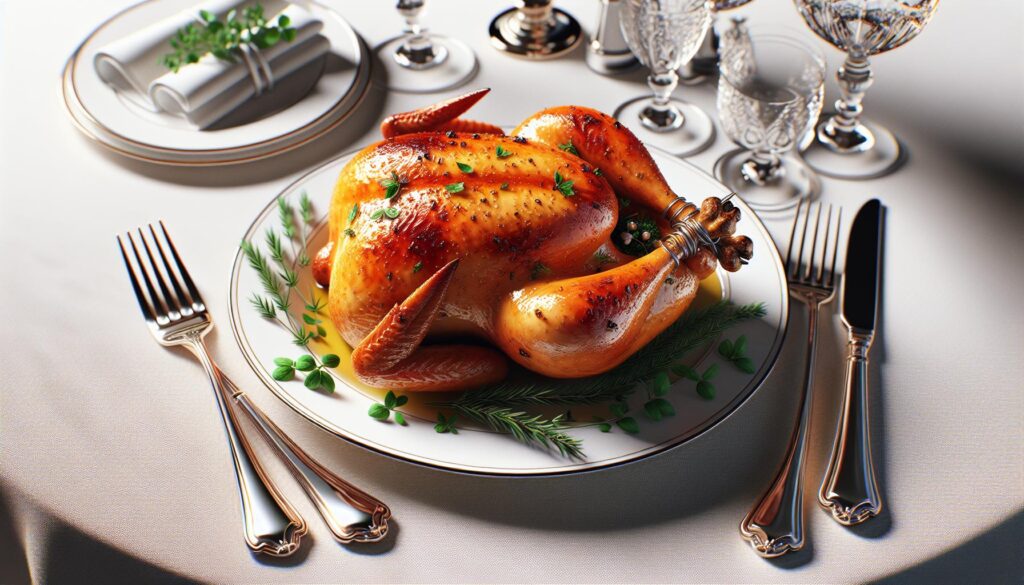I’ve always been fascinated by the delicate and flavorful Cornish hen, a petite poultry option that brings elegance to any dining table. As a chef, I’ve discovered that these small birds pack an impressive punch when it comes to taste and presentation.
My years of cooking experience have taught me that Cornish hens are perfect for both casual family dinners and sophisticated dinner parties. Unlike their larger chicken cousins, these compact birds typically weigh between 1-2 pounds and offer a more personalized dining experience since one bird usually serves a single person. I’ll share my expertise on selecting, preparing, and cooking these delightful birds to achieve that perfect golden-brown skin and juicy meat.
Key Takeaways
- Cornish hens are hybrid birds weighing 1-2 pounds, perfect for individual servings and elegant dining presentations
- These young chickens reach market weight in 4-5 weeks and feature tender, fine-grained meat with a higher flavor concentration than regular chicken
- Store fresh Cornish hens at 40°F for up to 2 days, or freeze at 0°F for up to 6 months to maintain quality
- Cook Cornish hens at 375°F for 50-60 minutes until internal temperature reaches 165°F, using either roasting or grilling methods
- A 3.5-ounce serving provides 24 grams of protein and essential minerals while remaining low in calories (140) and fat (4g)
Alive:as-dhgmovzg= Cornish Hen
A Cornish hen is a hybrid breed of chicken, specifically a cross between Cornish and White Plymouth Rock chickens. These petite birds typically reach market weight at 2 pounds or less, making them smaller than standard chickens.
The term “Cornish hen” can be misleading for three key reasons:
- They’re not exclusively from Cornwall, England
- Both male and female birds are marketed as Cornish hens
- They’re actually chickens, not a separate species of poultry
These birds feature distinctive characteristics:
- Compact, broad-breasted body structure
- White feathers and golden skin
- Tender, fine-grained meat
- Enhanced flavor concentration due to their small size
| Characteristic | Measurement |
|---|---|
| Average Weight | 1-2 pounds |
| Age at Market | 4-5 weeks |
| Meat-to-Bone Ratio | 70:30 |
| Typical Serving Size | 1 bird per person |
The USDA defines Cornish hens as young, immature chickens weighing between 1-2 pounds. These birds undergo processing at an earlier age than traditional broiler chickens, contributing to their tender texture and delicate flavor profile.
I appreciate their consistent size uniformity, which enables precise cooking times and temperatures. Their compact size creates an elegant presentation on individual plates, setting them apart from conventional chicken dishes.
History and Origin of the Cornish Hen Breed

The Cornish hen’s journey began in the 1950s on a Connecticut farm by Tea Makowsky, who crossbred Cornish game cocks with other chicken breeds. This innovative breeding program created a smaller, meatier bird that revolutionized poultry farming.
Development as a Commercial Meat Bird
The commercial development of Cornish hens started in 1965 when Tyson Foods acquired the breeding rights. Victor Borge, a renowned entertainer, partnered with Makowsky to market these birds as “Rock Cornish Game Hens,” establishing them in upscale restaurants. The success led to:
- Introduction of automated processing systems in 1970
- Implementation of selective breeding for consistent size
- Development of specialized feed formulations
- Establishment of standardized growing practices
- Integration of vertical production methods
Traditional Farming Methods
Early Cornish hen farming emphasized specific cultivation practices:
- Free-range rearing in small flocks of 50-100 birds
- Natural foraging supplemented with grain feeds
- 4-5 week growing cycles in controlled environments
- Manual processing techniques
- Individual bird monitoring for optimal weight control
| Year | Production Volume | Average Market Weight | Time to Market |
|---|---|---|---|
| 1950 | 10,000 birds | 2.2 pounds | 6-7 weeks |
| 1970 | 1 million birds | 2.0 pounds | 5-6 weeks |
| 1990 | 5 million birds | 1.8 pounds | 4-5 weeks |
Selecting and Preparing Cornish Hens

I select Cornish hens based on specific quality markers to ensure the best dining experience. Proper storage and handling techniques preserve their delicate flavor and maintain food safety standards.
Quality Indicators to Look For
Fresh Cornish hens display clear signs of quality through visual cues and physical characteristics:
- Skin color appears pale yellow to golden without discoloration spots
- Flesh feels firm when gently pressed not soft or mushy
- Package contains minimal liquid indicating proper processing
- Weight ranges between 1-1.5 pounds for optimal portion size
- USDA grade A stamp confirms highest quality standards
- Packaging shows no tears rips or signs of freezer burn
- Store fresh hens at 40°F or below in original packaging
- Place in refrigerator’s bottom shelf to prevent cross-contamination
- Use fresh Cornish hens within 2 days of purchase
- Keep frozen hens at 0°F maintaining constant temperature
- Thaw frozen birds in refrigerator for 24-36 hours
- Remove giblets from cavity before preparation
- Pat dry with paper towels to ensure crispy skin
- Bring to room temperature 30 minutes before cooking
| Storage Method | Temperature | Maximum Storage Time |
|---|---|---|
| Fresh Refrigerated | 40°F | 2 days |
| Frozen | 0°F | 6 months |
| Thawed | 40°F | 24 hours |
Cooking Methods and Techniques

Cornish hens adapt to multiple cooking methods that enhance their natural flavors. I’ve mastered several techniques to achieve perfectly cooked birds with crispy skin and juicy meat.
Roasting and Grilling Tips
Roasting Cornish hens at 375°F for 50-60 minutes yields optimal results. I place the birds breast-side up on a roasting rack to ensure even cooking and position a meat thermometer in the thickest part of the thigh to reach 165°F. For grilling, I maintain a medium-high heat (375-400°F) and cook for 45-50 minutes with indirect heat, turning every 15 minutes.
Key roasting steps:
- Preheat oven to 375°F
- Position hens on a rack in a roasting pan
- Brush with oil or melted butter
- Cook until internal temperature reaches 165°F
- Rest for 10 minutes before serving
Grilling technique checklist:
- Create two temperature zones on the grill
- Oil the grates to prevent sticking
- Place hens on indirect heat side
- Rotate every 15 minutes
- Baste regularly with pan drippings
Popular Seasonings and Marinades
The compact size of Cornish hens allows flavors to penetrate quickly. I recommend these proven combinations:
Basic herb blend:
- 2 tablespoons fresh rosemary
- 2 tablespoons fresh thyme
- 3 cloves minced garlic
- 1 tablespoon olive oil
- 1 teaspoon black pepper
Marinade options:
- Citrus-herb: lemon juice + oregano + olive oil
- Asian-inspired: soy sauce + ginger + honey
- Mediterranean: garlic + lemon + herbs de Provence
- Spicy: paprika + cayenne + garlic powder
- Apply marinades 4-6 hours before cooking
- Rub herb blends under the skin
- Season cavity with salt + pepper
- Baste with pan juices every 15-20 minutes
- Apply glazes during final 15 minutes
Health Benefits and Nutrition Facts
Cornish hens provide essential nutrients in a portion-controlled serving size. The nutritional profile of these small birds makes them an excellent choice for health-conscious diners.
Protein and Mineral Content
A 3.5-ounce serving of Cornish hen contains 24 grams of protein with minimal fat content. Here’s a detailed breakdown of the key nutrients:
| Nutrient | Amount per 3.5 oz serving |
|---|---|
| Protein | 24g |
| Iron | 1.4mg |
| Zinc | 2.1mg |
| Selenium | 22mcg |
| Phosphorus | 190mg |
| Potassium | 220mg |
The high protein content supports muscle maintenance while essential minerals contribute to various bodily functions. Iron promotes oxygen transport throughout the body while zinc supports immune function.
Dietary Considerations
Cornish hens fit into multiple dietary patterns due to their lean protein profile. Each 3.5-ounce serving contains:
| Nutritional Factor | Amount |
|---|---|
| Calories | 140 |
| Total Fat | 4g |
| Saturated Fat | 1g |
| Cholesterol | 75mg |
| Sodium | 60mg |
- Contain zero carbohydrates making them suitable for low-carb diets
- Provide complete protein with all essential amino acids
- Create smaller portions ideal for portion control
- Deliver nutrients without artificial additives or preservatives
- Accommodate gluten-free dietary requirements
Culinary Experience
My years of culinary experience have shown me that Cornish hens are truly a remarkable poultry option. These petite birds offer an elegant dining experience that’s both versatile and nutritious. I’m confident that with the right selection preparation and cooking techniques you’ll create memorable meals that wow your guests.
Whether you’re planning an intimate dinner or a special celebration these golden-skinned beauties deliver exceptional results. I’ve found their manageable size and consistent quality make them an ideal choice for both novice cooks and seasoned chefs. Now it’s your turn to explore the wonderful world of Cornish hens and discover their delightful possibilities.
